#LANMAN
Explore tagged Tumblr posts
Text
Tình cờ lướt qua một bài viết ngắn ngắn của em nào đấy, thấy ngợi khen những em "đa đoan" với "lo vẹn tròn bổn phận", rồi "rạch ròi", rồi "an nhiên", v.v.. trời, muốn đâu-cái- điền vậy đó :))
Gọi là sự thanh tỉnh thì có vẻ hợp, chứ đa đoan là cái nỗi rì mà vậy cưng?
2 notes
·
View notes
Text

Sáng mở zalo ra thấy câu "Hôm nay bạn thế nào?"
Mình chán. Hiện tại thứ gây chán cho mình nhiều nhất hẳn là công việc. Mình thấy bớt hẳn những niềm vui từ công việc. Cảm giác mình được trả lương chủ yếu để nghe những lời mình không muốn nghe, giao tiếp những kiểu giao tiếp mình không muốn, chấp nhận những ánh mắt, cử chỉ và hành động mình không muốn nhận. Làm việc với những con người, những tính cách mà nếu ở bên ngoài công ty mình chắc chắn hạn chế triệt để kết nối với họ. Sáng nay mình bước ra khỏi nhà với tâm trạng như vậy. Và vẫn phải tiếp tục công việc này ít nhất một năm nữa. Chả biết làm sao để vực dậy tinh thần, chìm nghỉm rồi. Đang nghĩ, hay là kiếm cái giếng cạn nào đó chui xuống ngồi thu lu một thời gian xem có ngẫm ngợi được điều gì khai minh hay không. Ảnh hưởng do đang chìm đắm trong cuốn Biên niên kí chim vặn dây cót. Kaka. Thôi, quay lại với công việc, với sân khấu công ty đây.
0 notes
Text
I love you April March (I only know Chick Habit)
#chick habit#whimsy mlm#but i’m a cheerleader#april march#Elinor Lanman Blake#France pop#French Indie Pop
2 notes
·
View notes
Text
youtube
Martin Glover doesn't have a brand he's associated with outside his nickname. Thus, I don't think he has a preferred style, he moves within many of them, yet him working with Heather Nova does show that his loyalties lie in alternative rock music. I mean, he produced her most famous album, Oyster, which could be described as the most 90's of the 90's platters in the similar vein. Still, that shouldn't suggest she's terrible – she's highly uneven as the review at Allmusic says, because her highs are incredible, though her lows do detract us from them. Nonetheless, we should applaud the fact she continues to work, whereas many of her contemporaries turned to the nostalgia circuits. She moved within the mainstream, but she didn't become swallowed by that.
#Youtube#heather nova#oyster#walk this world#david ayers#nadia lanman#dean mccormick#hossan ramzy#bob thompson#felix tod#youth#martin glover#90's music#alternative rock
0 notes
Text









Puff Q&A
As published in The Times (Munster, Indiana) on August 8, 2000:
You asked the questions and we passed them along. Check out what the girls had to say to you. Q: Blossom, why do you always wear a red bow in your hair? Kayla Rosiar, 6, Calumet CH Blossom: Because I'm the leader and it goes wonderfully with my long red hair. Q: Bubbles, why are you a little afraid of bugs? They are harmless. Reyna Ortiz, 9, Hammond Bubbles: Bugs are gross, gross, gross! Except for ladybugs, of course. They're sweet and pretty. Q: Buttercup, what Is your favorite thing about kicking evil butt? Victoria Hanson, 11, Valparaiso Buttercup: Everything. I like kicking and punching and showing those bad guys that bad doesn't get you anything but trouble.



Q: Blossom, is it hard having two sisters that are the same age as you? How do you keep them out of your stuff? Jesslyn Truesdale, 7, Calumet City Blossom: No, it's not hard, since we've been together from the beginning. And since Bubbles and Buttercup have completely different interests, it's not hard to keep them out of my stuff. Buttercup likes stuff like punching bags, Bubbles likes crayons and I like books. Q: Bubbles, why do you think Buttercup is mean to you? Miranda Russell, 13, Valparaiso Bubbles: I think she's jealous because she can't color like me. Buttercup: Yeah, right. Q: Dear Buttercup: Why are you so angry all the time? James Oppolo, 5, Hammond Buttercup: I'm not angry. I'm just tough on crime and criminals. Q: Did you have a mom? I'm asking all of you. Allison Penilla, 9, Schererrille Blossom: Nope. Bubbles: Just the Professor. Buttercup: And he's the best dad anyone could ask for. Q: Why doesn't the mayor have a real name like George? Lauren Rental, 10, Hammond Blossom: It's just easier to call him the Mayor. Then he remembers what his job is. Q: Why don't they show the mayor's secretary's face? Kaitlyn Jagar, 10, Hammond Blossom: Ms. Bellum? Buttercup: We see her face all the time. Bubbles: She's beautiful. Q: Bubbles, can you talk to animals? Elizabeth Lanman, 5, Munster Bubbles: Yes, I can speak squirrel and monster and all other animal languages. Q: Dear Bubbles, I want to know if flying is fun. Selena Castillo, 4, Hammond Bubbles: Flying is the funnest. I get to see all the beautiful colors from way up high! Q: Buttercup, why did you pick green for your outfit? Trisha Madura, 5, Munster Buttercup: 'Cause green is awesome. Much stronger than that pink and blue that Blossom and Bubbles wear. Q: Blossom, what do you do in school? Tiffany Madura, 7, Munster Blossom: I like reading and writing and math. Anything to make my young mind grow. Q: Do you like Britney Spears? Karlie Figiel, 5, Hammond Blossom: I like classical music. Buttercup: I like rock. Bubbles: I like birdies singing. Q: What was your first show about? Kelsie Figiel, 7, Hammond Blossom: Well, there was that battle with Roach Coach. He wanted to take over the world, with his army of roaches. Buttercup: That was so cool! Bubbles: No, it wasn't! It was gross! All those bugs! Yuck! Q: How do the Powerpuff girls stay big and strong? Because they fight Mojo Jojo so much? Ellen Wyand, 4, Crown Point Blossom: We stay big and strong because we are superheroes. Bubbles: Thanks to Chemical X. Buttercup: But beating up Mojo sure doesn't hurt.
#the powerpuff girls#powerpuff girls#cartoon network#cartoon cartoons#blossom#bubbles#buttercup#ppg#craig mccracken#y2k
139 notes
·
View notes
Text
MIT scientists pin down the origins of a fast radio burst
New Post has been published on https://thedigitalinsider.com/mit-scientists-pin-down-the-origins-of-a-fast-radio-burst/
MIT scientists pin down the origins of a fast radio burst


Fast radio bursts are brief and brilliant explosions of radio waves emitted by extremely compact objects such as neutron stars and possibly black holes. These fleeting fireworks last for just a thousandth of a second and can carry an enormous amount of energy — enough to briefly outshine entire galaxies.
Since the first fast radio burst (FRB) was discovered in 2007, astronomers have detected thousands of FRBs, whose locations range from within our own galaxy to as far as 8 billion light-years away. Exactly how these cosmic radio flares are launched is a highly contested unknown.
Now, astronomers at MIT have pinned down the origins of at least one fast radio burst using a novel technique that could do the same for other FRBs. In their new study, appearing today in the journal Nature, the team focused on FRB 20221022A — a previously discovered fast radio burst that was detected from a galaxy about 200 million light-years away.
The team zeroed in further to determine the precise location of the radio signal by analyzing its “scintillation,” similar to how stars twinkle in the night sky. The scientists studied changes in the FRB’s brightness and determined that the burst must have originated from the immediate vicinity of its source, rather than much further out, as some models have predicted.
The team estimates that FRB 20221022A exploded from a region that is extremely close to a rotating neutron star, 10,000 kilometers away at most. That’s less than the distance between New York and Singapore. At such close range, the burst likely emerged from the neutron star’s magnetosphere — a highly magnetic region immediately surrounding the ultracompact star.
The team’s findings provide the first conclusive evidence that a fast radio burst can originate from the magnetosphere, the highly magnetic environment immediately surrounding an extremely compact object.
“In these environments of neutron stars, the magnetic fields are really at the limits of what the universe can produce,” says lead author Kenzie Nimmo, a postdoc in MIT’s Kavli Institute for Astrophysics and Space Research. “There’s been a lot of debate about whether this bright radio emission could even escape from that extreme plasma.”
“Around these highly magnetic neutron stars, also known as magnetars, atoms can’t exist — they would just get torn apart by the magnetic fields,” says Kiyoshi Masui, associate professor of physics at MIT. “The exciting thing here is, we find that the energy stored in those magnetic fields, close to the source, is twisting and reconfiguring such that it can be released as radio waves that we can see halfway across the universe.”
The study’s MIT co-authors include Adam Lanman, Shion Andrew, Daniele Michilli, and Kaitlyn Shin, along with collaborators from multiple institutions.
Burst size
Detections of fast radio bursts have ramped up in recent years, due to the Canadian Hydrogen Intensity Mapping Experiment (CHIME). The radio telescope array comprises four large, stationary receivers, each shaped like a half-pipe, that are tuned to detect radio emissions within a range that is highly sensitive to fast radio bursts.
Since 2020, CHIME has detected thousands of FRBs from all over the universe. While scientists generally agree that the bursts arise from extremely compact objects, the exact physics driving the FRBs is unclear. Some models predict that fast radio bursts should come from the turbulent magnetosphere immediately surrounding a compact object, while others predict that the bursts should originate much further out, as part of a shockwave that propagates away from the central object.
To distinguish between the two scenarios, and determine where fast radio bursts arise, the team considered scintillation — the effect that occurs when light from a small bright source such as a star, filters through some medium, such as a galaxy’s gas. As the starlight filters through the gas, it bends in ways that make it appear, to a distant observer, as if the star is twinkling. The smaller or the farther away an object is, the more it twinkles. The light from larger or closer objects, such as planets in our own solar system, experience less bending, and therefore do not appear to twinkle.
The team reasoned that if they could estimate the degree to which an FRB scintillates, they might determine the relative size of the region from where the FRB originated. The smaller the region, the closer in the burst would be to its source, and the more likely it is to have come from a magnetically turbulent environment. The larger the region, the farther the burst would be, giving support to the idea that FRBs stem from far-out shockwaves.
Twinkle pattern
To test their idea, the researchers looked to FRB 20221022A, a fast radio burst that was detected by CHIME in 2022. The signal lasts about two milliseconds, and is a relatively run-of-the-mill FRB, in terms of its brightness. However, the team’s collaborators at McGill University found that FRB 20221022A exhibited one standout property: The light from the burst was highly polarized, with the angle of polarization tracing a smooth S-shaped curve. This pattern is interpreted as evidence that the FRB emission site is rotating — a characteristic previously observed in pulsars, which are highly magnetized, rotating neutron stars.
To see a similar polarization in fast radio bursts was a first, suggesting that the signal may have arisen from the close-in vicinity of a neutron star. The McGill team’s results are reported in a companion paper today in Nature.
The MIT team realized that if FRB 20221022A originated from close to a neutron star, they should be able to prove this, using scintillation.
In their new study, Nimmo and her colleagues analyzed data from CHIME and observed steep variations in brightness that signaled scintillation — in other words, the FRB was twinkling. They confirmed that there is gas somewhere between the telescope and FRB that is bending and filtering the radio waves. The team then determined where this gas could be located, confirming that gas within the FRB’s host galaxy was responsible for some of the scintillation observed. This gas acted as a natural lens, allowing the researchers to zoom in on the FRB site and determine that the burst originated from an extremely small region, estimated to be about 10,000 kilometers wide.
“This means that the FRB is probably within hundreds of thousands of kilometers from the source,” Nimmo says. “That’s very close. For comparison, we would expect the signal would be more than tens of millions of kilometers away if it originated from a shockwave, and we would see no scintillation at all.”
“Zooming in to a 10,000-kilometer region, from a distance of 200 million light years, is like being able to measure the width of a DNA helix, which is about 2 nanometers wide, on the surface of the moon,” Masui says. “There’s an amazing range of scales involved.”
The team’s results, combined with the findings from the McGill team, rule out the possibility that FRB 20221022A emerged from the outskirts of a compact object. Instead, the studies prove for the first time that fast radio bursts can originate from very close to a neutron star, in highly chaotic magnetic environments.
“These bursts are always happening, and CHIME detects several a day,” Masui says. “There may be a lot of diversity in how and where they occur, and this scintillation technique will be really useful in helping to disentangle the various physics that drive these bursts.”
This research was supported by various institutions including the Canada Foundation for Innovation, the Dunlap Institute for Astronomy and Astrophysics at the University of Toronto, the Canadian Institute for Advanced Research, the Trottier Space Institute at McGill University, and the University of British Columbia.
#000#2022#amazing#Astronomy#Astronomy and astrophysics#Astrophysics#atoms#author#billion#Black holes#Canada#comparison#data#diversity#DNA#driving#Emissions#energy#Environment#explosions#fast radio bursts#Filters#Foundation#galaxies#Galaxy#gas#Giving#how#hydrogen#Innovation
49 notes
·
View notes
Text
Greely Expedition Publications and Media
See anything missing from the list below? Let me know!
Last Updated April 23, 2025
Narrative Histories:
Abandoned in the Arctic: Adolphus W. Greely and the Lady Franklin Bay Expedition, 1881-1884 Geoffrey E. Clark ISBN: 978-0974089522
Ghosts of Cape Sabine: The Harrowing True Story of the Greely Expedition Leonard F. Guttridge, 2000 Print ISBN: 0-425-17654-1
Labyrinth of Ice: The Triumphant and Tragic Greely Expedition Buddy Levy, 2019 Print ISBN: 978-1-250-78206-9
Abandoned: The Story of the Greely Arctic Expedition 1881-1884 Alden Todd, 1961 Print ISBN: 1-889963-29-1
Memoirs and Biographies:
The Outpost of the Lost David L. Brainard, 1929 Print ISBN: 978-1-5107-3521-7 (An abridged version of Brainard's diary from August 1883 to June 1884)
Three Years of Arctic Service Adolphus W. Greely, 1886 Bib ID: 2344946 Free Digital Copy: https://archive.org/details/threeyearsofarct02gree/page/n5/mode/2up
Farthest North; or the Life and Explorations of Lieutenant James Booth Lockwood, of the Greely Arctic Expedition Charles Lanman, 1885 Gutenberg EBook #54019 Free Digital Copy: https://www.gutenberg.org/files/54019/old/54019-h/54019-h.htm
Canada's Forgotten Arctic Hero: George Rice and the Lady Franklin Bay Expeditionm 1881-1884 Jim Lotz ISBN: 9781895415940
In the Lena Delta George W. Melville, 1885 Library of Congress #: 04016772 Free Digital Copy: https://play.google.com/store/books/details?id=O20SAAAAYAAJ&rdid=book-O20SAAAAYAAJ&rdot=1
Six Came Back David Brainard, 1940 No free, digital, or mass-print copies available (An abridged version of Brainard's diaries from 1881 to 1883. Very few copies available for less than $100 US)
Expedition Member Diaries:
Adolphus Greely (abridged and published as Three Years of Arctic Service, see above): https://www.pbs.org/wgbh/americanexperience/features/greely-journal/
David Brainard (abridged and published as The Outpost of the Lost, see above): https://collections.dartmouth.edu/teitexts/brainard-diary/diplomatic/brainard-2-diary-diplomatic.html#?start=0&length=12&view=list&col=brainard-diary&oc_0=main-title&od_0=a
George Rice: https://www.pbs.org/wgbh/americanexperience/features/greely-rice-journal/
Hampden Gardiner: a partial transcript and scans of Gardiner's journals was provided via US CECOM - hit me up to receive a copy
Documentaries and Video Essays:
Abandoned in the Arctic PBS, 2007 https://www.pbs.org/show/abandoned-arctic/
American Experience: The Greely Expedition PBS, 2011 https://www.pbs.org/wgbh/americanexperience/films/greely/ Currently available to rent/buy on Amazon Prime, but follow the link for image galleries and primary sources.
Tragedy on the Ice: U-M Astronomy and the Ill-Fated Greely Polar Expedition University of Michigan, 2023 Available on Youtube: https://www.youtube.com/watch?v=WqcmYerIKrA
Polar Survival: The Lady Franklin Bay Expedition of 1881-1884 The History Guy, 2021 Available on Youtube: https://www.youtube.com/watch?v=i4abprNgpnU
Fiction:
Starvation Shore Laura Waterman, 2019 ISBN: 9780299323400
The Greely Expedition's Fatal Quest for Farthest North Golriz Golkar, 2023 ISBN: 9781666390629
Websites:
Science and Survival at Fort Conger Virtual Museum Canada https://fortconger.org/index
Articles and Blog Posts:
David L. Brainard and the Greely Expedition of 1881-1884 Cecilia Brainard https://cbrainard.blogspot.com/2016/01/david-l-brainard-and-greely-expedition.html (A blog post about the author's spouse's ancestor: our own David Brainard! She's also recently published a book of short stories!)
In The Archives: Edward Israel's Polar Sky Laura Bien, 2011, The Ann Arbor Chronicle https://annarborchronicle.com/2011/01/21/in-the-archives-edward-israels-polar-sky/index.html
A Tale of Survival, Wrapped in a 19th-Century Reindeer-Skin Sleeping Bag Betsy Golden Kellem, 2020, Atlas Obscura https://www.atlasobscura.com/articles/caribou-sleeping-bag
Ghosts of Discovery Harbor: Digging for Data Andreas Muenchow https://icyseas.org/2016/02/11/ghosts-of-discovery-harbor-digging-for-data/#comments
An Arctic Execution: Private Charles B. Henry of the United States Lady Franklin Bay Expedition Glenn M. Stein https://glennmstein.com/wp-content/uploads/2024/04/An-Arctic-Execution-Charles-B.-Henry-LFBE-2011.pdf
The Arctic Exploits of Dr. Octave Pavy Douglas Wamsley https://www.researchgate.net/publication/276748841_The_Arctic_Exploits_of_Dr_Octave_Pavy
19 notes
·
View notes
Text

The origins of a fast radio burst
Fast radio bursts are brief and brilliant explosions of radio waves emitted by extremely compact objects such as neutron stars and possibly black holes. These fleeting fireworks last for just a thousandth of a second and can carry an enormous amount of energy — enough to briefly outshine entire galaxies.
Since the first fast radio burst (FRB) was discovered in 2007, astronomers have detected thousands of FRBs, whose locations range from within our own galaxy to as far as 8 billion light-years away. Exactly how these cosmic radio flares are launched is a highly contested unknown.
Now, astronomers at MIT have pinned down the origins of at least one fast radio burst using a novel technique that could do the same for other FRBs. In their new study, appearing in the journal Nature, the team focused on FRB 20221022A — a previously discovered fast radio burst that was detected from a galaxy about 200 million light-years away.
The team zeroed in further to determine the precise location of the radio signal by analyzing its “scintillation,” similar to how stars twinkle in the night sky. The scientists studied changes in the FRB’s brightness and determined that the burst must have originated from the immediate vicinity of its source, rather than much further out, as some models have predicted.
The team estimates that FRB 20221022A exploded from a region that is extremely close to a rotating neutron star, 10,000 kilometers away at most. That’s less than the distance between New York and Singapore. At such close range, the burst likely emerged from the neutron star’s magnetosphere — a highly magnetic region immediately surrounding the ultracompact star.
The team’s findings provide the first conclusive evidence that a fast radio burst can originate from the magnetosphere, the highly magnetic environment immediately surrounding an extremely compact object.
“In these environments of neutron stars, the magnetic fields are really at the limits of what the universe can produce,” says lead author Kenzie Nimmo, a postdoc in MIT’s Kavli Institute for Astrophysics and Space Research. “There’s been a lot of debate about whether this bright radio emission could even escape from that extreme plasma.”
“Around these highly magnetic neutron stars, also known as magnetars, atoms can’t exist — they would just get torn apart by the magnetic fields,” says Kiyoshi Masui, associate professor of physics at MIT. “The exciting thing here is, we find that the energy stored in those magnetic fields, close to the source, is twisting and reconfiguring such that it can be released as radio waves that we can see halfway across the universe.”
The study’s MIT co-authors include Adam Lanman, Shion Andrew, Daniele Michilli, and Kaitlyn Shin, along with collaborators from multiple institutions.
Burst size
Detections of fast radio bursts have ramped up in recent years, due to the Canadian Hydrogen Intensity Mapping Experiment (CHIME). The radio telescope array comprises four large, stationary receivers, each shaped like a half-pipe, that are tuned to detect radio emissions within a range that is highly sensitive to fast radio bursts.
Since 2020, CHIME has detected thousands of FRBs from all over the universe. While scientists generally agree that the bursts arise from extremely compact objects, the exact physics driving the FRBs is unclear. Some models predict that fast radio bursts should come from the turbulent magnetosphere immediately surrounding a compact object, while others predict that the bursts should originate much further out, as part of a shockwave that propagates away from the central object.
To distinguish between the two scenarios, and determine where fast radio bursts arise, the team considered scintillation — the effect that occurs when light from a small bright source such as a star, filters through some medium, such as a galaxy’s gas. As the starlight filters through the gas, it bends in ways that make it appear, to a distant observer, as if the star is twinkling. The smaller or the farther away an object is, the more it twinkles. The light from larger or closer objects, such as planets in our own solar system, experience less bending, and therefore do not appear to twinkle.
The team reasoned that if they could estimate the degree to which an FRB scintillates, they might determine the relative size of the region from where the FRB originated. The smaller the region, the closer in the burst would be to its source, and the more likely it is to have come from a magnetically turbulent environment. The larger the region, the farther the burst would be, giving support to the idea that FRBs stem from far-out shockwaves.
Twinkle pattern
To test their idea, the researchers looked to FRB 20221022A, a fast radio burst that was detected by CHIME in 2022. The signal lasts about two milliseconds, and is a relatively run-of-the-mill FRB, in terms of its brightness. However, the team’s collaborators at McGill University found that FRB 20221022A exhibited one standout property: The light from the burst was highly polarized, with the angle of polarization tracing a smooth S-shaped curve. This pattern is interpreted as evidence that the FRB emission site is rotating — a characteristic previously observed in pulsars, which are highly magnetized, rotating neutron stars.
To see a similar polarization in fast radio bursts was a first, suggesting that the signal may have arisen from the close-in vicinity of a neutron star. The McGill team’s results are reported in a companion paper today in Nature.
The MIT team realized that if FRB 20221022A originated from close to a neutron star, they should be able to prove this, using scintillation.
In their new study, Nimmo and her colleagues analyzed data from CHIME and observed steep variations in brightness that signaled scintillation — in other words, the FRB was twinkling. They confirmed that there is gas somewhere between the telescope and FRB that is bending and filtering the radio waves. The team then determined where this gas could be located, confirming that gas within the FRB’s host galaxy was responsible for some of the scintillation observed. This gas acted as a natural lens, allowing the researchers to zoom in on the FRB site and determine that the burst originated from an extremely small region, estimated to be about 10,000 kilometers wide.
“This means that the FRB is probably within hundreds of thousands of kilometers from the source,” Nimmo says. “That’s very close. For comparison, we would expect the signal would be more than tens of millions of kilometers away if it originated from a shockwave, and we would see no scintillation at all.”
“Zooming in to a 10,000-kilometer region, from a distance of 200 million light years, is like being able to measure the width of a DNA helix, which is about 2 nanometers wide, on the surface of the moon,” Masui says. “There’s an amazing range of scales involved.”
The team’s results, combined with the findings from the McGill team, rule out the possibility that FRB 20221022A emerged from the outskirts of a compact object. Instead, the studies prove for the first time that fast radio bursts can originate from very close to a neutron star, in highly chaotic magnetic environments.
“These bursts are always happening, and CHIME detects several a day,” Masui says. “There may be a lot of diversity in how and where they occur, and this scintillation technique will be really useful in helping to disentangle the various physics that drive these bursts.”
8 notes
·
View notes
Text
Ren's scent profile and favorites of 2024
So a couple months back I put in my tags that I've been exploring different scents namely "mens" colgenes and bodywashes. It was kind of intimating, especially when I'd be in shops smelling body washes and colgenes with men in the same aisle but who gaf I probably smell better than them anyway.
In no particular order:
Cremo Bourbon and oak body wash paired with dr squatch wood barrel bourbon soap + midnight birch. 10/10 my favorite and I've repurchased the soap and body wash atleast 4 times this year. Absolutely obsessed with Midnight birch and my girlfriend is all over me when I wear it.
Dove Cherry and chia milk body wash paired with dove unscented "soap" bar, cherry almond lotion by Blessed assurance farms (I didnt realize the guy was Christian but its local and made with goats milk) and Princess by Vera wang (Ive had it for a couple years). 9/10 I love the body wash and have become a big fan of cherry scents. It's definitely a combo I reach for. Only complaint is that (just like usual sweet smells for me) it can all be overwhelming to wear all at once. My girlfriend also likes to use the body wash herself 👩🏻❤️💋👩🏼
Lanman and Kemp Flordia water soap paired with Flordia water colgene OR cheome by rue 21 and cucumber lotion by PINK. 7/10 Lowest rating but still very good. The soaps smell doesn't last very long and the colgene dries my skin out due to its high alcohol content (all perfumes and colgenes have it), the lotion was given to me as a employee perk when I worked at Victoria's secret last summer. Will definitely finish but not buy this combo again. I like the fresh and gardeny smell though.
Dislikes:
Gourmand and artificial sweet smells (ie strawberry poundcake by bath and body works)
Irish spring refresh. I tried so hard to like it especially with its lavender notes but it was so chemically and overpowered anything I paired it with.
Fresh creme by philosophy. Despite it being left behind by my dead mother I don't wear it as I dont like vanilla scents, way too strong but will be keeping for sentimental sake
Random roll on perfume with Obsidian crystals from my cities holistic festival. Just smells like floor cleaner despite being called Divine, pairs well with the flordia water though.
Was (shortly) obsessed with this in the beginning of the year but bleu de chanel just sucks, it smells like toothpaste and im glad it was a magazine sample size. I prefer the other sample sample I got, Burberry hero
Scent profile
•Woody and oaky, a sweet light musk with a dash of spice. (Bourbon and oak, midnight birch)
•Fruity and fresh scents, natural sweetness (Cucumber lotion, and cherry almond, Chrome)
Would like to try/wish list
Cremo Italian bergamot paired with summer citrus by dr squatch (I promise im not sponsored by them I just love their shit)
Some sort of musky floral bodywash similar to Night magic by avon, like what Irish spring refresh should've been.
Super berry set by PINK (I tried it while on the sales floor and I luv it)
Uomo born in roma, expensive as hell but is definitely a very sexy and moody unisex option I'd love to have
#when I was figuring out what I liked I wanted to have 3 options: (stereotypically)masculine and feminine scents and something unisex.#a little silly to say but I wanted a middle ground bc I didn't wanna risk being made fun of for wearing colgene and “smelling like a man”#when I say “naturally sweet” scents I mean like the cherry almond and lavender and flowery scents
3 notes
·
View notes
Text

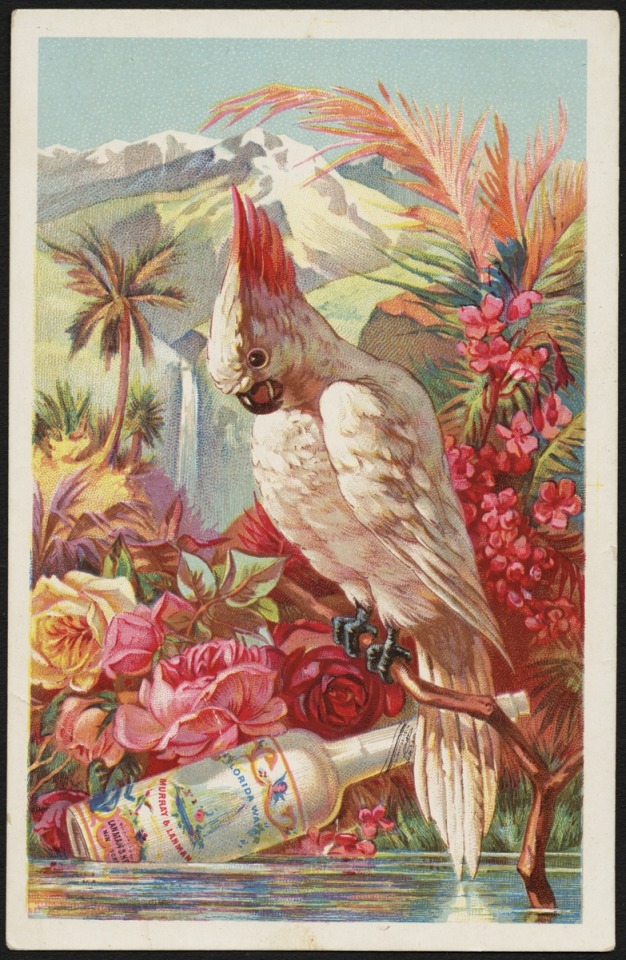


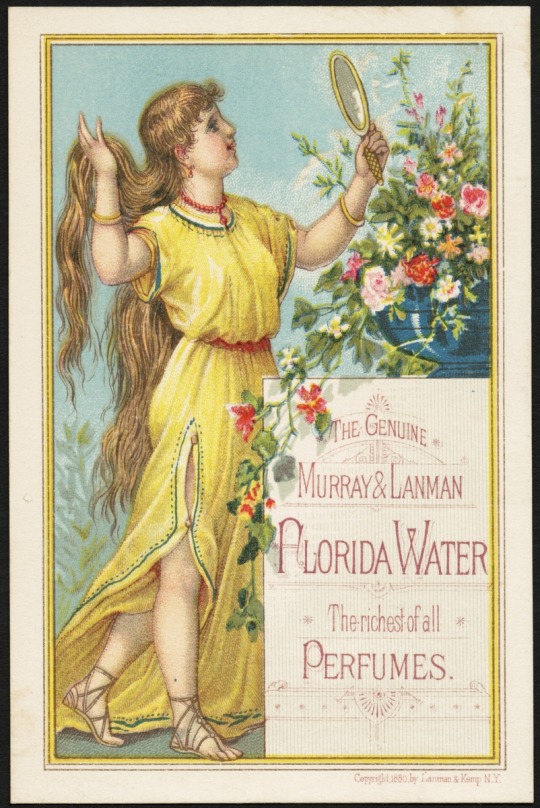

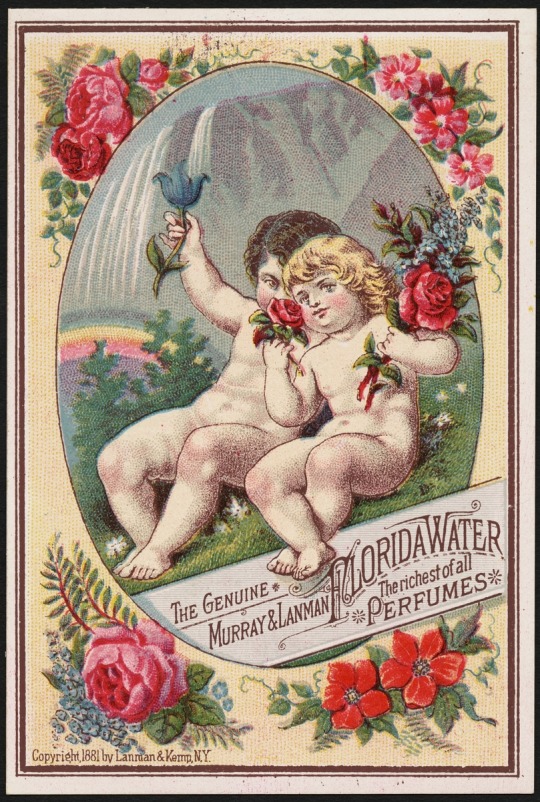
My favorite genre of Murray & Lanman Florida Water advertisement is "gorgeous overstuffed scene with weird animal scoping out perfume" but I will also accept scenes with people lounging around and fucking around with their hair, because that's what I do 90% of the time when I'm wearing Florida Water.
13 notes
·
View notes
Text
Three Eaux de Cologne (Guerlain)
Tomas -- the cheerful philanderer of Milan Kundera's novel The Unbearable Lightness of Being -- adheres to a self-written code of ethics when arranging his many liaisons. "The important thing," he claims, "is to abide by the rule of threes. Either you see a woman three times in quick succession and then never again, or you maintain relations over the years but make sure that the rendezvous are at least three weeks apart".
Tomas breaks his own rule by remaining with (and even marrying) the tormented Tereza-- but the woman who "understands him best" is Sabina, an artist with whom he shares a bond untrammeled by jealousy or possessiveness. While Tereza represents all that is heavy and serious, Sabina personifies the weightlessness of freedom from attachment. Over time, her ephemeral quality proves contradictory to both Tomas and Tereza, for while she slips in and out of their lives, they cannot forget her-- nor she them. There is something about Sabina which lingers in memory, if not in actuality.
If Sabina were a fragrance, could she be anything but eau de cologne?
When something lovely, brief, plentiful, and refreshing is called for, eau de cologne is the obvious answer. Other fragrance compositions are "heavy" -- complex, deliberate, meant to be taken (and worn) seriously. Cologne is "light" -- a fleeting pleasure intended for impromptu use.
Yet for all its transience, eau de cologne can make a deep impression on the psyche. Many perfume wearers I've met tell of the indelible mark made in their memories by a certain fragrance worn by an older relative. More than half the time, that fragrance is an EDC. The paradox inherent in eau de cologne is that one enjoys so brief a time with it-- but once the bond is established, loyalty lasts a lifetime.
The first eau de cologne released by Giovanni Maria Farina in 1709 set a new standard in fragrance composition and usage. The rules were simple: take a base of orange blossom, peel, and leaf essential oils. Combine them variously with other citrus oils (lemon, lime, mandarin, grapefruit, bergamot), herbs (rosemary, thyme, lavender, artemisia), and florals (usually indolic white flowers such as jasmine or narcissus). Dilute the result in a disproportionately large amount of alcohol (up to nine parts out of ten). Lose the inhibitions, and start splashing it on.
Guerlain's introduction to the eau de cologne playing field came fairly late in the game (1853), by which time the genre was well-established. Guerlain's contribution was the use of stronger aromatic fixatives such as musk and cedar, which preserved the airiness of the classic EDC format while extending its life by a crucial heartbeat. Aside from Farina 1709 Original, 4711 Kölnisch Wasser, and Lanman & Murray Florida Water, the Guerlain series of eaux offers about the best introduction to the eau de cologne aesthetic that I can think of.
Over the last two weeks -- during which the East Coast became a veritable EZ-Bake Oven and the B.O. factor among the public I serve reached an all-time ascendancy -- I've thoroughly enjoyed flitting back and forth between Impériale, Fleurs de Cédrat, and Eau de Guerlain. If breezy, fresh, and fruity is the antidote to summer doldrums, I never needed it more than now.
Created in 1853, Eau de Cologne Impériale is the oldest of Guerlain's colognes. It kicks off with an intense lemon-lime accord, vibrant and exuberant, before revealing its beautiful-but-brief verveine-and-orange-blossom heart. Of course it lasts no longer on skin than it has taken me to type these words, but it's not meant to. One only needs a momentary boost to avoid slipping into a hot-weather case of the vapours.
Eau de Fleurs de Cédrat requires a little more time to appreciate. This one's a sorbet, creamy in texture but not milky in the slightest, with the dryness of powdered sugar and a mild animalic element which keeps it on skin somewhat longer than its counterparts. Its name is a subtle play on words, touching on cèdrat (citron) and cèdre (cedar), both of which it contains. Whether one is more prominent than the other appears to be a matter for the weatherman to decide. On a cooler day -- if you want to call 90°F "cooler"! -- I found much more orange blossom filling the air around me. During a scorcher, the emphasis is on cedarwood. Either way, enchantée.
What can be said about Eau de Guerlain that could possibly further embellish its well-deserved reputation? In descriptive terms, one could call it a delicious lemon-creme and herbal eau de cologne, and stop right there. Who needs more?
Well, I do.
Having never really tried my hand at layering before, I enlisted the Guerlain eaux within the last week for a running experiment in this time-honored perfume practice. Impériale and Eau de Guerlain were close enough in temperament so as to seem destined to be together, while Fleurs de Cédrat -- while playing well with others -- did just as well on its own. I would like to say that nothing could beat the three eaux layered together, one on top of the other. But as it happened, a bottom layer of Tauer's Lonestar Memories propelled the trio into a new and unexpected paradise. (Who knew that Guerlain could benefit from a touch of the dude ranch?)
Sabina, maybe. At the close of The Unbearable Lightness of Being, she too has migrated toward the setting sun-- settling fitfully on the West Coast, where she continues to create despite the alien quality of life around her. Upon learning of Tomas' and Tereza's demise, she writes a will stipulating that her cremated ashes be dispersed to the four winds, so that she may "die under the sign of lightness".
As she has lived, so Sabina will live on-- faithless, free, and true to her inner nature. She would, says Kundera, be lighter than air.
Scent Elements: Hesperides and herbs
#guerlain#Eau de Cologne Impériale#Eau de Guerlain#Eau de Fleurs de Cédrat#perfume review#parfümieren
2 notes
·
View notes
Text
HEARD OF FLORIDA WATER? HERE'S WHY IT'S THE ONE THING YOUR RITUALS ARE MISSING

By Sarah Regan
If you've never heard of Florida water, let's get one thing out of the way first: No, this is not the water you'll find in the state of Florida. Rather, it's a special liquid that's believed to help enhance any number of rituals.
Here, we dive into what makes Florida water so potent, the best ways to use it, and how to make it yourself.
Florida water is an alcohol-based cologne first used in the early 1800s as a perfume. More recently, it has become a staple in mystical practices, explains the author of Revolutionary Witchcraft Sarah Lyons. It's primarily made by the company Murray & Lanman and carries a very citrusy, floral scent.
As Gabriela Herstik, author of Inner Witch and Bewitching the Elements, adds, it was given the name "Florida water" because the Fountain of Youth is said to be somewhere in Florida. She and Lyons both note that today, it's used for offerings, cleansing, and more and is popular among those who practice hoodoo, rootwork, and American folk magic.
Spiritual uses of Florida water
Here are 20 ways you can incorporate Florida water into your own practices, according to Herstik and Lyons.
Note: Florida water is flammable, so always be mindful when using it around candles.
Offer it to your ancestors or guides on your altar in a bowl.
Have some in a bowl nearby when communing with ancestors or guides and asking them for advice.
Place a small bowl of Florida water on your altar as an offering of self-love.
Wipe your mirror with diluted Florida water, and then do a self-love ritual of your choosing in front of the mirror.
Energetically cleanse yourself with Florida water by spraying it around you or putting a bit on your wrists.
Energetically (and literally) cleanse ritual tools like crystals with a bit of diluted Florida water to give them a refresh.
Use it to cleanse your altar and anything on it by diluting some with water in a spray bottle and spraying on your altar, then wiping down.
Use it in your usual floor cleaner to cleanse your home and wash away negative energy.
Fill a small bowl with spring water, Florida water, and a piece of a bluing square if you have one. Place the bowl by your front door to draw out negative energy from your home. Replace the water once a week.
Use it as the water element in rituals, along with a candle for fire, a crystal or rock for earth, and incense for air. (It's considered powerful to have all four elements present when doing rituals.)
Dilute Florida water with spring water in a spray bottle and use the spray to cleanse any room in your home.
Spray some diluted Florida water around you or your space before you begin a tarot reading.
Spray some diluted Florida water around you or your space before meditating.
Anoint yourself with a bit of Florida water (emphasis on just a bit!) if you want an energetic refresh or a boost of creativity and inspiration.
Use it alongside any spells or rituals for attracting love to increase the potency of the spell/ritual.
Wear a bit like perfume whenever you want protection.
Keep some in your workplace or on your desk to welcome positive energy and banish negativity.
Spray some diluted Florida water and patchouli essential oil on your cash for extra abundance.
Add a bit of Florida water to your laundry (especially bedding if you frequently have nightmares) for protection.
Place some in a bowl on your nightstand to more easily remember your dreams.
How to make it yourself
The beauty of Florida water is it's super simple to make yourself and very customizable based on your intention. Herstik and Lyons do recommend getting it from a credible source if you want the "real" thing, though they're not against making your own. Here's what you'll need:
Materials
1 cup vodka
1 orange peel (or lemon peel)
1 lemon peel
8 to 10 drops of your essential oil of choice. (Traditional oils for Florida water include lavender, lemon, bergamot, and ylang-ylang)
A handful or two of fresh herbs of your choosing (i.e., mint or basil)
1 cinnamon stick (optional)
Method
Combine all your ingredients into a glass container and seal it.
Let the mixture sit for a full lunar cycle (29 days).
Optional: Make it on the night of a full moon and let it charge under the moon's light. Even if you don't make it on the night of a full moon, you can still place it under moonlight when the next full moon comes around.
Where to buy Florida water
If you'd rather skip over the DIY and go with an already-made option, Lyons highly recommends buying it from people who practice hoodoo, rootwork, and American folk magic, "since those are the traditions that first began using it in magic."
Herstik adds that you're likely to find Florida water in your local Botanica stores or witch shops at very reasonable prices, so be sure to check there first.
The takeaway
Whether you're doing a ritual, cleansing your home, or making an offering to your ancestors, incorporating Florida water can be a way to make the ceremony even more powerful.
2 notes
·
View notes
Text
Why Our Waistlines Expand In Middle Age—Aging Stem Cells Shift Into Overdrive
— By City of Hope National Medical Center

Adipogenesis Contributes to Age-related Visceral Adipose Tissue Accumulation. Credit: Science (2025). DOI: 10.1126/science.adj0430
It's no secret that our waistlines often expand in middle age, but the problem isn't strictly cosmetic. Belly fat accelerates aging and slows down metabolism, increasing our risk for developing diabetes, heart problems and other chronic diseases. Exactly how age transforms a six pack into a softer stomach, however, is murky.
Now preclinical research by City of Hope has uncovered the cellular culprit behind age-related abdominal fat, providing new insights into why our midsections widen with middle age.
Published today in Science, the findings suggest a novel target for future therapies to prevent belly flab and extend our healthy lifespans.
"People often lose muscle and gain body fat as they age—even when their body weight remains the same," said Qiong (Annabel) Wang, Ph.D., the study's co-corresponding author and an associate professor of molecular and cellular endocrinology at City of Hope's Arthur Riggs Diabetes & Metabolism Research Institute.
"We discovered aging triggers the arrival of a new type of adult stem cell and enhances the body's massive production of new fat cells, especially around the belly."
In collaboration with the UCLA laboratory co-corresponding author Xia Yang, Ph.D., the scientists conducted a series of mouse experiments later validated on human cells. Wang and her colleagues focused on white adipose tissue (WAT), the fatty tissue responsible for age-related weight gain.
While it's well-known that fat cells grow larger with age, the scientists suspected that WAT also expanded by producing new fat cells, meaning it may have an unlimited potential to grow.
To test their hypothesis, the researchers focused on adipocyte progenitor cells (APCs), a group of stem cells in WAT that evolve into fat cells.
The City of Hope team first transplanted APCs from young and older mice into a second group of young mice. The APCs from the older animals rapidly generated a colossal amount of fat cells.
When the team transplanted APCs from young mice into the older mice, however, the stem cells did not manufacture many new fat cells. The results confirmed that older APCs are equipped to independently make new fat cells, regardless of their host's age.
Using single-cell RNA sequencing, the scientists next compared APC gene activity in young and older mice. While barely active in young mice, APCs woke up with a vengeance in middle-aged mice and began pumping out new fat cells.
"While most adult stem cells' capacity to grow wanes with age, the opposite holds true with APCs—aging unlocks these cells' power to evolve and spread," said Adolfo Garcia-Ocana, Ph.D., the Ruth B. & Robert K. Lanman Endowed Chair in Gene Regulation & Drug Discovery Research and chair of the Department of Molecular & Cellular Endocrinology at City of Hope. "This is the first evidence that our bellies expand with age due to the APCs' high output of new fat cells."
Aging also transformed the APCs into a new type of stem cell called committed preadipocytes, age-specific (CP-As). Arising in middle age, CP-A cells actively churn out new fat cells, explaining why older mice gain more weight.
A signaling pathway called leukemia inhibitory factor receptor (LIFR) proved critical for promoting these CP-A cells to multiply and evolve into fat cells.
"We discovered that the body's fat-making process is driven by LIFR. While young mice don't require this signal to make fat, older mice do," explained Wang. "Our research indicates that LIFR plays a crucial role in triggering CP-As to create new fat cells and expand belly fat in older mice."
Using single-cell RNA sequencing on samples from people of various ages, Wang and her colleagues next studied APCs from human tissue in the lab. Again, the team also identified similar CP-A cells that had an increased number in middle-aged people's tissue. Their discovery also illustrates that CP-As in humans have high capacity in creating new fat cells.
"Our findings highlight the importance of controlling new fat-cell formation to address age-related obesity," said Wang. "Understanding the role of CP-As in metabolic disorders and how these cells emerge during aging could lead to new medical solutions for reducing belly fat and improving health and longevity."
Future research will focus on tracking CP-A cells in animal models, observing CP-A cells in humans and developing new strategies that eliminate or block the cells to prevent age-related fat gain.
— Friday March 25, 2025
— The Study's First Authors are City of Hope's Guan Wang, Ph.D., and UCLA's Gaoyan Li, Ph.D.
#Overweight & Obesity#Endocrinology & Metabolism#Waistlines#Middle Age#Aging Stem Cells | Shift | Overdrive#City of Hope National Medical Center#MedicalXpress.Com#Journal Information: Science
0 notes
Text
A
3 Swords Germany - 1927
Altoid - 1780 #2
B
Beer
Bee & Flower - 1928
Bianchi - 1885
Bicycle PC - 1885
Bigelow - 1838
Bic France - 1945
Bologna
Brooks Brothers - 1818 #4
Budweiser - 1876
Buick - 1903
C
Cadillac
Canada Dry - 1904
Casio - April 1946
Champion - 1919
Chanel - 1910
Choward's Violet - 1934
Chuck Taylor - 1932
Cigarette
Continental Tires - October 8, 1871
Corn Bread
Crayola - 1902
D
Dishes
Dickies - 1900
Dr. Martin - 1947
F
Fallout
Fender - 1946
Fiat
Footjoy - 1857
G
Gola - 1905
Goodfellow & Co - 2017
Gucci - 1921
H
Handkerchief
Hohner Accordion/Harmonica - 1857
Hoodies - 1930
Huffy Bicycles - 1892
I
Izod - 1938
J
Jell-O - 1897
Jeep - 1941
John Deere - 1837 #5
John Weitz - 1947
L
Lacoste - 1933
Lamp
LANMAN & KEMP Since 1808 FLORIDA WATER
Levi Strauss & Co - 1853
L.L. Bean - 1912
Lv - 1854
M
Markall B - 1934
Mason Jar
Merriam-Webster - 1828
Modelo Cerveza - 1925
Morris Code - 1838 #6
Murrays - 1925
N
Nag Champa
New Balance - 1906
P
Perrier - 1863
Pinaud - 1810 #3
Plates
Pro-Keds - 1949
R
Range Finder
Ray-Ban - 1937
Reebok - 1895
Rolex - 1905
S
S.Pellegrino - 1899
Schwinn - 1895
Sears Roebuck - 1893
Silverware
Solo Cup Co - 1936
Soup
Stella Artois - 1366
Strumey Archer - 1902
T
Target - 1902
Tiger Balm - 1800
Timex - 1854
Tins
Tootsie Roll - 1896
Twinkie Cake - 1930
Typing - 1875
V
Volkswagen - 1937
W
Wine
Wrangler - 1947
Z
Zildjian - 1623 #1
1 note
·
View note
Text

A statue of Brahma, The Creator, 9th century, Java, Source: The MET Museum of Art
Hinduism in Bali: Things You Need to Know
From its mountain-topped temples to its colorful and vibrant rituals, Bali is home to a truly unique form of Hinduism

Page from the Vedas, Codex Cashmiriensis folio 187a from Atharva-Veda Saṁhitā second half, compiled by William Dwight Whitney and Charles Rockwell Lanman, 1905, Source: Wikimedia Commons

Prambanan, a fine example of surviving Hindu temples on Java, photo by Suman Sinha, 9th century, Source: Flickr

Looking down over the Mother Temple of Besakih, by Juan Antonia Segal, Source: Flickr

Ulun Danu Bratan Temple, Bali, Source: Flickr

Statue of Ganesh, Bali, by Artem Baliaikin, Source: Unsplash
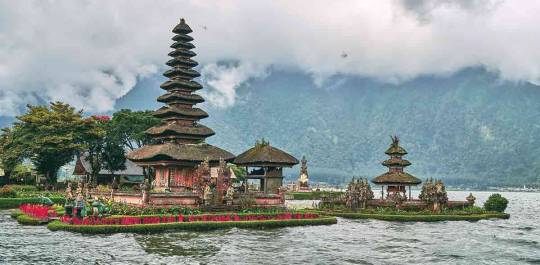
Pura Bratan Water Temple in Bali, by Norbert Braun, Source: Unsplash
0 notes
Text
MIT scientists pin down the origins of a fast radio burst
New Post has been published on https://sunalei.org/news/mit-scientists-pin-down-the-origins-of-a-fast-radio-burst/
MIT scientists pin down the origins of a fast radio burst
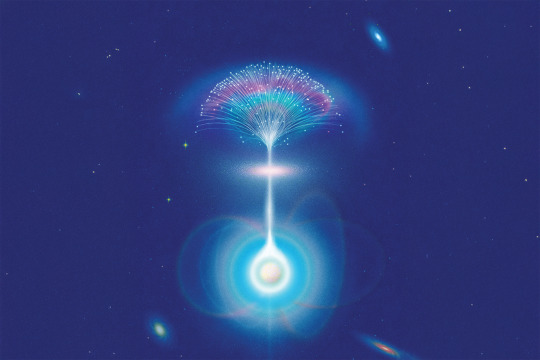
Fast radio bursts are brief and brilliant explosions of radio waves emitted by extremely compact objects such as neutron stars and possibly black holes. These fleeting fireworks last for just a thousandth of a second and can carry an enormous amount of energy — enough to briefly outshine entire galaxies.
Since the first fast radio burst (FRB) was discovered in 2007, astronomers have detected thousands of FRBs, whose locations range from within our own galaxy to as far as 8 billion light-years away. Exactly how these cosmic radio flares are launched is a highly contested unknown.
Now, astronomers at MIT have pinned down the origins of at least one fast radio burst using a novel technique that could do the same for other FRBs. In their new study, appearing today in the journal Nature, the team focused on FRB 20221022A — a previously discovered fast radio burst that was detected from a galaxy about 200 million light-years away.
The team zeroed in further to determine the precise location of the radio signal by analyzing its “scintillation,” similar to how stars twinkle in the night sky. The scientists studied changes in the FRB’s brightness and determined that the burst must have originated from the immediate vicinity of its source, rather than much further out, as some models have predicted.
The team estimates that FRB 20221022A exploded from a region that is extremely close to a rotating neutron star, 10,000 kilometers away at most. That’s less than the distance between New York and Singapore. At such close range, the burst likely emerged from the neutron star’s magnetosphere — a highly magnetic region immediately surrounding the ultracompact star.
The team’s findings provide the first conclusive evidence that a fast radio burst can originate from the magnetosphere, the highly magnetic environment immediately surrounding an extremely compact object.
“In these environments of neutron stars, the magnetic fields are really at the limits of what the universe can produce,” says lead author Kenzie Nimmo, a postdoc in MIT’s Kavli Institute for Astrophysics and Space Research. “There’s been a lot of debate about whether this bright radio emission could even escape from that extreme plasma.”
“Around these highly magnetic neutron stars, also known as magnetars, atoms can’t exist — they would just get torn apart by the magnetic fields,” says Kiyoshi Masui, associate professor of physics at MIT. “The exciting thing here is, we find that the energy stored in those magnetic fields, close to the source, is twisting and reconfiguring such that it can be released as radio waves that we can see halfway across the universe.”
The study’s MIT co-authors include Adam Lanman, Shion Andrew, Daniele Michilli, and Kaitlyn Shin, along with collaborators from multiple institutions.
Burst size
Detections of fast radio bursts have ramped up in recent years, due to the Canadian Hydrogen Intensity Mapping Experiment (CHIME). The radio telescope array comprises four large, stationary receivers, each shaped like a half-pipe, that are tuned to detect radio emissions within a range that is highly sensitive to fast radio bursts.
Since 2020, CHIME has detected thousands of FRBs from all over the universe. While scientists generally agree that the bursts arise from extremely compact objects, the exact physics driving the FRBs is unclear. Some models predict that fast radio bursts should come from the turbulent magnetosphere immediately surrounding a compact object, while others predict that the bursts should originate much further out, as part of a shockwave that propagates away from the central object.
To distinguish between the two scenarios, and determine where fast radio bursts arise, the team considered scintillation — the effect that occurs when light from a small bright source such as a star, filters through some medium, such as a galaxy’s gas. As the starlight filters through the gas, it bends in ways that make it appear, to a distant observer, as if the star is twinkling. The smaller or the farther away an object is, the more it twinkles. The light from larger or closer objects, such as planets in our own solar system, experience less bending, and therefore do not appear to twinkle.
The team reasoned that if they could estimate the degree to which an FRB scintillates, they might determine the relative size of the region from where the FRB originated. The smaller the region, the closer in the burst would be to its source, and the more likely it is to have come from a magnetically turbulent environment. The larger the region, the farther the burst would be, giving support to the idea that FRBs stem from far-out shockwaves.
Twinkle pattern
To test their idea, the researchers looked to FRB 20221022A, a fast radio burst that was detected by CHIME in 2022. The signal lasts about two milliseconds, and is a relatively run-of-the-mill FRB, in terms of its brightness. However, the team’s collaborators at McGill University found that FRB 20221022A exhibited one standout property: The light from the burst was highly polarized, with the angle of polarization tracing a smooth S-shaped curve. This pattern is interpreted as evidence that the FRB emission site is rotating — a characteristic previously observed in pulsars, which are highly magnetized, rotating neutron stars.
To see a similar polarization in fast radio bursts was a first, suggesting that the signal may have arisen from the close-in vicinity of a neutron star. The McGill team’s results are reported in a companion paper today in Nature.
The MIT team realized that if FRB 20221022A originated from close to a neutron star, they should be able to prove this, using scintillation.
In their new study, Nimmo and her colleagues analyzed data from CHIME and observed steep variations in brightness that signaled scintillation — in other words, the FRB was twinkling. They confirmed that there is gas somewhere between the telescope and FRB that is bending and filtering the radio waves. The team then determined where this gas could be located, confirming that gas within the FRB’s host galaxy was responsible for some of the scintillation observed. This gas acted as a natural lens, allowing the researchers to zoom in on the FRB site and determine that the burst originated from an extremely small region, estimated to be about 10,000 kilometers wide.
“This means that the FRB is probably within hundreds of thousands of kilometers from the source,” Nimmo says. “That’s very close. For comparison, we would expect the signal would be more than tens of millions of kilometers away if it originated from a shockwave, and we would see no scintillation at all.”
“Zooming in to a 10,000-kilometer region, from a distance of 200 million light years, is like being able to measure the width of a DNA helix, which is about 2 nanometers wide, on the surface of the moon,” Masui says. “There’s an amazing range of scales involved.”
The team’s results, combined with the findings from the McGill team, rule out the possibility that FRB 20221022A emerged from the outskirts of a compact object. Instead, the studies prove for the first time that fast radio bursts can originate from very close to a neutron star, in highly chaotic magnetic environments.
“These bursts are always happening, and CHIME detects several a day,” Masui says. “There may be a lot of diversity in how and where they occur, and this scintillation technique will be really useful in helping to disentangle the various physics that drive these bursts.”
This research was supported by various institutions including the Canada Foundation for Innovation, the Dunlap Institute for Astronomy and Astrophysics at the University of Toronto, the Canadian Institute for Advanced Research, the Trottier Space Institute at McGill University, and the University of British Columbia.
0 notes